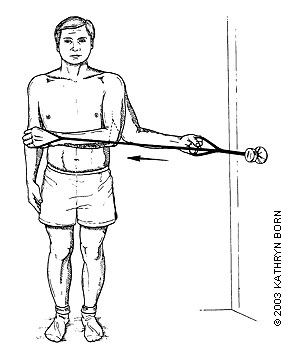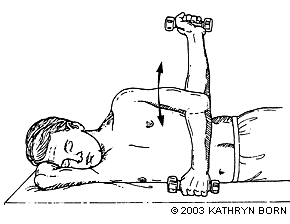
Am Fam Physician. 2003;67(6):1319-1320
What causes pain in my shoulder?
A common cause of shoulder pain is soreness of the tendon in the rotator cuff. The tendon is a cord that attaches a muscle to another body part. The rotator cuff is the part of the shoulder that helps the arm do a circular motion. Another common cause of shoulder pain is soreness of the subacromial bursa (say: sub-ak-rome-ee-all bur-sah). This is a pad of fluid under the highest part of the shoulder. You might have soreness after activities that require you to lift your arms, like painting a house, lifting boxes, or playing tennis. Or you may not be aware of any specific injury or activity.
The main shoulder joint is formed by the arm bone and the shoulder blade. The joint socket is shallow to allow a wide range of motion in the arm. The rotator cuff is made up of four muscles that surround the arm bone. This cuff keeps the shoulder steady as the arm moves.
How does the rotator cuff get hurt?
One of the muscles rests on top of the shoulder. Its tendon travels under the bone on the outside of the shoulder. This tendon is the one most often injured because of its position between the bones. As the tendon becomes inflamed (sore and swollen), it can be pinched between the two bones. The pad of fluid that cushions the tendon also can be damaged.
How do I know my rotator cuff is hurt?
If the rotator cuff is involved, the pain usually is in the front or outside of your shoulder. This pain usually is worse when you raise your arm or lift something above your head. The pain can be bad enough to keep you from doing even the simplest tasks. Pain at night is common, and it may be bad enough to wake you up.
What can I do to help the pain?
Treatment should do two things: (1) help your pain and (2) help you get back normal function in your shoulder. Pain relief includes the following steps:
Active rest (no heavy lifting, but keep moving your shoulder)
Physical treatments such as ultrasound
Application of ice
Medicine such as ibuprofen (some brands: Advil, Motrin, Nuprin) or naproxen (brand name: Aleve)
Occasionally, an injection of steroids into your shoulder
Normal function can be restored with special exercises. The first step is simple range-of-motion exercises. By bending over and moving (rotating) your shoulder in large circles, you can help avoid a serious complication of rotator cuff injury, called frozen shoulder. Range-of-motion exercises are followed by exercises using rubber tubing or light dumbbells. The final step is training with weight machines or free weights.
What exercises should I do?

Are there other things I can do to help this injury heal?
An aerobic exercise program will help improve the blood flow to the tendon and bursa. Increased blood flow helps reduce soreness. Smokers should quit smoking so that more oxygen will reach the injured tendon. This will help the injury heal faster.

Will I need surgery?
Sometimes an injury that lasts a long time will cause the tendon to tear. This type of injury may need surgery. You might have a torn rotator cuff if the pain goes on in spite of a good exercise program or if you have weakness in certain arm motions.
